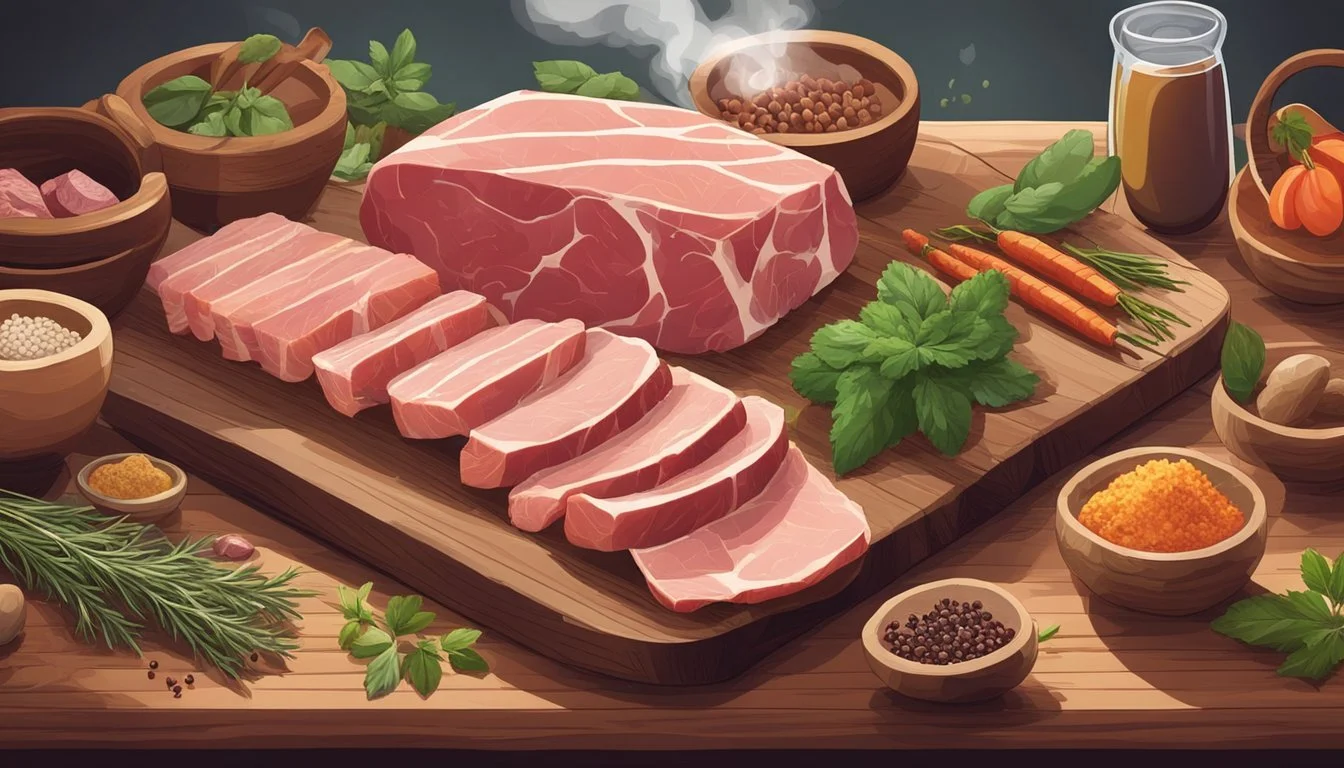How to Make Carnivore Diet-Friendly Smoked Meats
A Guide to Mouthwatering Flavors
The Carnivore Diet, centered around the consumption of animal products, emphasizes meats as its staple. Health benefits associated with this diet include potential weight loss, reduced inflammation, and simplicity in meal planning. For enthusiasts looking to enhance the flavor profile of their meat-centric meals, incorporating smoked meats (What wine goes well with smoked meats?) can be an innovative way to diversify their diet without compromising on dietary principles. Smoking meat, a time-honored technique, imparts a depth of flavor that can make carnivore diet meals more enjoyable.
Smoking meats aligns with the carnivore diet's focus on meat as it requires minimal ingredients—primarily the meat itself, and optionally, salt. The absence of sugary rubs or sauces keeps the dish within the diet's guidelines, ensuring meals are both flavorful and compliant. When smoking meat, it is important to maintain a balance between achieving a rich smoky flavor and preserving the meat's natural quality. This cooking technique not only enhances taste but can also contribute to tenderness, making less desirable cuts more palatable.
To adapt smoking techniques to the Carnivore Diet, experts advocate using simple seasonings, if any, and allowing the natural essence of the meat to prevail. Adherents can choose from a variety of meats, from beef (how long does beef last?) brisket to trout, each offering unique textures and nutrient profiles. The preparation process emphasizes dry smoking to avoid introducing non-animal products, and the cooking method highlights the use of low and slow temperatures to retain the healthful properties of the meat while infusing the desired smoky flavor.
Fundamentals of the Carnivore Diet
The Carnivore Diet is an elimination diet centered around animal-based ingredients and is often adopted for its simplicity and potential health benefits. This dietary approach emphasizes consumption of protein and fat, largely from meats, while excluding plant-based foods. It is characterized by a strict focus on the following components:
Whole Proteins: Meats like beef, pork, lamb, and poultry form the basis of the diet, prioritizing nutrient-dense options.
Fats: Essential for energy and nutrient absorption, sources of fat include butter, lard, and the natural fat found in meats.
Dairy: While not a staple for everyone on the Carnivore Diet, certain forms of dairy, particularly high-fat and low-lactose options like butter and hard cheeses, can be included.
The inclusion of dairy is subjective and varies based on individual tolerance and dietary goals.
Here is a basic structure for the carnivore diet:
Breakfast
Eggs, bacon (how long does bacon last?), pork sausages (What wine goes well with pork sausages?)
Lunch
Chicken, beef, or fish, possibly accompanied by a slice of cheese
Dinner
Variety of red meats, organ meats, or seafood
Practitioners often adopt a meal frequency that suits their individual needs, which may range from one to three meals per day. Cooking methods include grilling, roasting, and sautéing, with a general recommendation to prepare meats to personal preference. Drinking only water is also commonly advised.
Since the Carnivore Diet consists almost exclusively of animal-based ingredients, it's critical for individuals to ensure they are consuming a variety of meats, including organ meats and fatty cuts, to maintain nutritional adequacy.
When it comes to lard, online shopping is the way to go!
Choosing the Right Meats
When preparing carnivore diet-friendly smoked meats, selecting quality cuts is essential. The focus should be on a variety of meats to keep the diet diverse and nutritionally adequate, prioritizing grass-fed and high-quality animal products where possible.
Beef Selection
For beef, one should opt for cuts that are rich in marbling and flavor. Grass-fed beef is often preferred for its higher concentration of omega-3 fatty acids and vitamins. Ideal cuts for smoking include brisket, ribeye, and New York strip. These cuts not only deliver on taste but also align well with the high-fat principles of the carnivore diet. A trusted butcher can be an invaluable resource in selecting the best cut for smoking.
Pork Selection
Pork provides a succulent smoked meat option, with cuts such as pork tenderloin and pork ribs (What wine goes well with pork ribs?) being top choices. The tenderloin is ideal for a leaner option, while the ribs provide a more indulgent experience. For those adhering strictly to a carnivore diet, it's essential to source pork that is free from additives and is as natural as possible.
Poultry Choices
Chicken, particularly fattier cuts like chicken thighs (What wine goes well with chicken thighs?), can be an excellent inclusion for variety in a carnivore diet. They are well-suited to smoking, which can impart a delicious flavor and ensure the meat remains moist. When available, one might consider other types of poultry, such as duck or turkey, to further enhance the range of options.
Game and Other Meats
Game meats like venison and lamb add unique flavors and textures to a carnivore diet. These meats are generally leaner and can benefit from the low and slow cooking process of smoking, which helps retain moisture. When it comes to organ meats, which are nutrient-dense and valuable in a carnivore diet, smoking can also be applied to enhance their taste profile. Grass-fed options are particularly desirable due to their nutritional superiority.
Preparation Basics
Before smoking meat for a carnivore diet, one must focus on the initial steps of preparation, which include trimming, seasoning, and, if preferred, curing. Each of these stages is crucial for enhancing the flavor and texture of the final dish.
Trimming and Cutting
Trimming excess fat and cutting the meat to uniform size ensures even cooking and an optimum smoke flavor. For ribs, one should remove the membrane on the back of the rack to allow the smoke to penetrate more deeply. With cuts like brisket, one should trim the fat cap to about a quarter inch to help render it down during the cooking process.
Salting and Seasoning
Salting is a pivotal step, as it works to both flavor the meat and alter protein structures, allowing for better moisture retention. Use coarse salt and freshly ground black pepper for a basic seasoning. One may consider adding herbs and spices such as thyme, rosemary, or paprika for a more complex flavor profile. For those adhering to a sugar-free approach, ensure all spice mixes are devoid of sugar and other non-carnivore ingredients.
Basic Rub Recipe for Carnivore Diet:
2 tbsp coarse salt
1 tbsp black pepper
1 tsp garlic powder (optional)
1 tsp onion powder (optional)
Note: Always opt for sugar-free seasoning to stay within carnivore diet guidelines.
Trust me, the easiest way to buy coarse salt, black pepper, garlic powder, and onion powder is through online retailers!
Curing and Marinating
Although curing and marinating are not always necessary for all types of smoked meats, they can add depth to the flavor. When choosing to cure, one should opt for salt-based cures without sugar. If marinating, simple solutions such as apple cider vinegar mixed with water, olive oil, or tallow can be used to tenderize the meat. It's crucial to keep these mixtures free from non-carnivorous ingredients to remain diet-compliant.
Get the best value for your money by purchasing apple cider vinegar, olive oil, or tallow online!
Smoking Techniques and Tips
The art of smoking meats on the carnivore diet involves precise wood selection, temperature control, and timing to achieve smoky, flavorful results that maintain moisture. Mastering these elements is key to the success of the cooking method and ensures delicious outcomes for any type of meat.
Wood Selection and Smoke Flavor
Choosing the right wood is essential for imparting the desired smoke flavor into the meat. Hardwoods like hickory and mesquite provide a strong, robust flavor, well-suited for red meats like beef brisket, (What wine goes well with beef brisket?) while apple and cherry wood offer a sweeter, milder taste that complements poultry and pork.
Strong Flavors: Hickory, Mesquite
Mild Flavors: Apple, Cherry
One should avoid using softwoods like pine, as they can impart unwanted flavors and contain sap that is unsuitable for smoking food.
Temperature Control
Maintaining a consistent temperature is crucial for smoking meats to preserve moisture and achieve a tender texture. Ideally, smoking temperatures should range from 225 to 250 degrees Fahrenheit. Using a water pan can aid in stabilizing the temperature and add humidity to the cooking environment, which helps in keeping the meat moist.
Ideal Temperature Range: 225-250°F
Water Pan: Adds humidity, stabilizes temperature
Temperature fluctuations should be minimized by carefully monitoring and adjusting the heat source as needed throughout the cooking process.
Meat Smoking Times
Different cuts and types of meat require varying smoking times to ensure they are cooked through and have absorbed enough smoke to be flavorful. For example, a full beef brisket can take anywhere from 12 to 18 hours to smoke properly, while ribs may only need about 5 to 6 hours.
One should always use a meat thermometer to check the internal temperature of the meat to ensure it is safe to eat and has reached the desired level of doneness.
Carnivore Diet-Friendly Recipes
Embracing the carnivore diet means focusing on high-quality animal proteins and fats. This section offers smoked meat-centric recipes that align with the carnivore diet, ranging from succulent snacks to satisfying main courses.
Savory Smoked Delights
Smoked meats provide a rich flavor and tender texture. Carnivore pizza is an excellent alternative to traditional pizza, using a ground beef crust topped with cheese and smoked meats of choice—ideal for a high-protein treat.
Innovative Carnivore Diet Snacks
For those seeking something unconventional, keto steak nuggets and carnivore fried chicken strips serve as perfect snacks. Both can be prepared by coating the meat in crushed pork rinds before smoking, offering a crunchy bite that's pure protein.
Dinner Specials with Smoked Meat
Dinner on the carnivore diet is a chance to indulge in heartier meals. A smoked taco pie, layered with ground beef, organ meats for nutritional depth, and cheese, creates a fulfilling entree. Pair with smoked bone marrow for an added dose of richness.
Carnivore Breakfast Options
To start one's day with intent, a carnivore's breakfast might include carnivore quiche (What wine goes well with quiche?) breakfast muffins, consisting of eggs, smoked sausage, bacon, and cheese, all baked together. Simple and portable, they make for a nutrient-dense beginning to any day.
Accompaniments and Sides
When preparing smoked meats for the carnivore diet, one emphasizes animal-based products. Side dishes, although limited in variety, can augment the meal, adding a satisfying diversity to the palate without deviating from the diet’s strict guidelines.
Meat-Rich Side dishes include options like deviled eggs with a bacon twist for added flavor. They can provide a balance of fats and proteins that complement the main smoked meats.
Deviled Eggs with Bacon:
Hard-boiled eggs
Mayonnaise or animal fats
Crumbled sugar-free bacon
Carnivore Sandwich Bread, an innovative alternative to traditional bread, can be made using eggs and animal fats to maintain a ketogenic profile while allowing diners to enjoy a form of sandwich.
Simplified Carnivore Bread:
Eggs, beaten into a froth
Melted butter or other preferred animal fats
Carnivore Noodles, another unique concept, can be crafted from egg whites and are suitable for those pursuing both carnivore and ketogenic lifestyles.
Homemade Egg White Noodles:
Whisk egg whites until slightly stiff.
Pour onto a greased baking sheet, spreading thinly.
Bake until set, then slice into noodle-like strips.
Alternately, thinly-sliced cuts of pork or beef, lightly seared, can serve as "noodles" in a dish offering both protein and a novel eating experience.
Lastly, for those seeking to enrich their dishes without straying from low-carb options, incorporating Animal Fats in cooking processes or as a condiment can be ideal. Butter, ghee, and bone marrow are all high-energy sides that directly align with the carnivore diet's principles, enhancing flavors and satiety.
Remember, the portion sizes should be adjusted according to individual dietary needs and the heaviness of the accompanying smoked meats.
Post-Cooking Tips
Once your carnivore diet-friendly smoked meats are cooked to perfection, proper storage and reheating are crucial to maintaining their flavor and safety.
Storing and Freezing
For optimal freshness, one should store smoked meats in the refrigerator at or below 40°F within two hours of cooking. Steaks and loins can be wrapped tightly in plastic wrap or aluminum foil, or placed in an airtight container. Here are specific tips:
Fridge: Keep smoked meats for up to four days.
Freezer: For long-term storage, it's best to freeze your smoked meats. Use freezer-safe bags or vacuum-sealed containers to prevent freezer burn.
Steps for Freezing:
Cool the meats completely before freezing.
Wrap each piece of meat individually.
Label the bags or containers with the date.
Reheating for Best Flavor
When one is ready to reheat leftover smoked meats, the goal is to restore the meat's moisture and flavor without overcooking.
For steaks and loins:
Oven method: Heat the oven to 250°F, place the meat in a baking dish, and add a small amount of broth or water. Cover with foil and heat until the internal temperature reaches 165°F.
Stovetop method: For a quicker option, one can simmer steaks and loins in a pan over low heat with a couple of tablespoons of water or broth.
By following these storage and reheating guidelines, smoked meats can maintain their quality and provide enjoyable meals beyond the initial cooking day.
Carnivore Diet Variations
When adapting smoked meats for the carnivore diet, individuals often explore variations to match their dietary goals and preferences. These can range from including ketogenic principles to emphasizing high-fat content or organ meats for nutritional variety.
Keto-Carnivore Combos
The synergy between the carnivore and ketogenic diets can be seen in the shared emphasis on low-carb, high-fat foods. Keto-carnivore variations typically include smoked meats with a higher fat content, such as pork belly (What wine goes well with pork belly?) or ribs. Implementing a keto diet approach, one prioritizes meats that contribute both to ketosis and carnivore diet simplicity.
Recommended Smoked Meats:
Pork belly
Ribs
Fattier cuts of beef
High-Fat Focus
In a high-fat carnivore variation, one deliberately seeks out meats with substantial fat content, which may involve selecting specific cuts or incorporating additional animal fats. The use of smoked salt and brown butter can further enrich these smoked dishes, augmenting both flavor and fat content.
Fat Enhancement Techniques:
Use of smoked salt
Addition of brown butter to finished dishes
Organ Meat Incorporation
One can maximize the nutritional value by incorporating organ meats such as liver into their carnivore diet. These meats are dense in essential nutrients and can be smoked for added depth of flavor. The inclusion of organ meats supports a nose-to-tail eating philosophy, fully embracing the carnivore ethos.
Examples of Smokable Organ Meats:
Liver
Heart
Kidneys
















